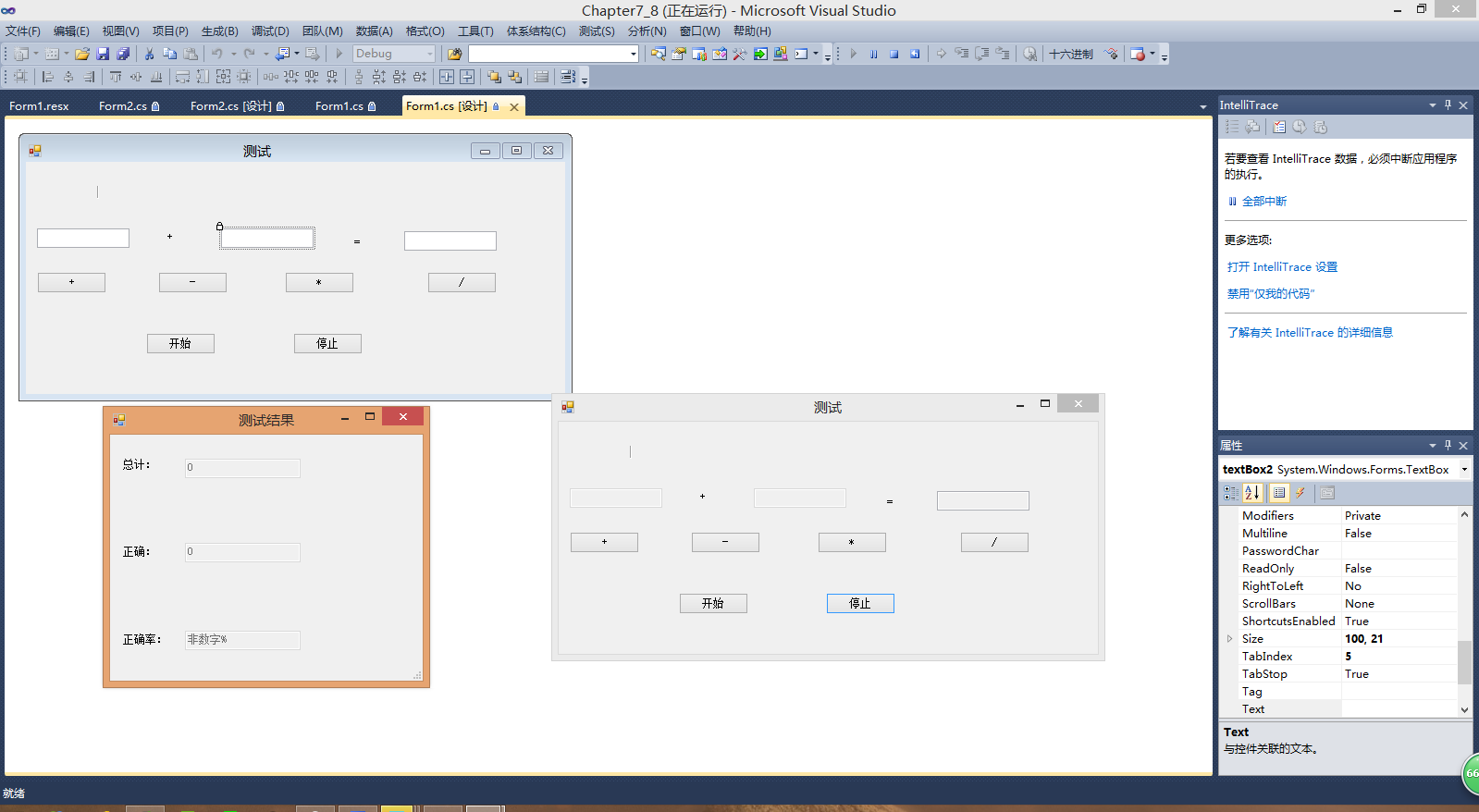一、需求分析:
1、当单击开始的时候,开始进行运算,单击回车键数字可以随机变换数字,单击停止跳转到Form2进行测试。
2、程序随机产生两个1-10的随机数,由用户输入结果。
3、停止时会输出正确率信息。
二、设计思路:
1、先建两个窗体,拉进去自己需要的控件,然后编写代码。
2、定义正确和总的题数的变量。
3、Random产生随机数。
4、textBox3计算加减乘除结果,单击开始运行。
5、停止转到Form2进行测试。
具体控件如下表
| 控件 | 属性 | 值 |
| Form1 | Text | 加法测试 |
| label1 | Text | + |
| label2 | Text | = |
| textBox1 | Enbled | false |
| textBox2 | Enbled | false |
| button1 | Text | 开始 |
| button2 | Text | 停止 |
| button3 | Text | + |
| button4 | Text | - |
| button5 | Text | * |
| button6 | Text | / |
| textBox3 | Enbled | false |
|
Form2 |
||
| label1 | Text | 总计: |
| label2 | Text | 正确: |
| label3 | Text | 正确率: |
| textBox1 | Enbled | false |
| textBox2 | Enbled | false |
| textBox3 | Enbled | false |
三、代码实现:
using System;
using System.Collections.Generic;
using System.ComponentModel;
using System.Data;
using System.Drawing;
using System.Linq;
using System.Text;
using System.Windows.Forms;
namespace Chapter7_8
{
public partial class Form1 : Form
{
public Form1()
{
InitializeComponent();
}
private void Form1_Load(object sender, EventArgs e)
{
}
public static int count = 0;//题目总数
public static int right = 0;//正确的题目总数
private void button1_Click(object sender, EventArgs e)
{
Random();
}
//产生1-10的随机数
private void Random()
{
Random ran = new Random();
int n1, n2;
n1 = ran.Next(1, 11);
n2 = ran.Next(1, 11);
textBox1.Text = n1.ToString();
textBox2.Text = n2.ToString();
textBox3.Text="";
count++;
}
//当按下回车键表示输入结果
private void textBox3_KeyDown(object sender, KeyEventArgs e)
{
int count;
string c = label2.Text;
switch (c)
{
case "+":
count = int.Parse(textBox1.Text) + int.Parse(textBox2.Text);
break;
case "-":
count = int.Parse(textBox1.Text) - int.Parse(textBox2.Text);
break;
case "x":
count = int.Parse(textBox1.Text) * int.Parse(textBox2.Text);
break;
default:
count = int.Parse(textBox1.Text) / int.Parse(textBox2.Text);
break;
}
if (e.KeyCode == Keys.Enter)
{
if (textBox3.Text == count.ToString())
right++;
Random();
}
}
private void button2_Click(object sender, EventArgs e)
{
textBox3.Enabled = false;
Form2 frm2 = new Form2();
frm2.ShowDialog();
}
private void button3_Click(object sender, EventArgs e)
{
label2.Text = "+";
Random();
}
private void button4_Click(object sender, EventArgs e)
{
label2.Text = "-";
Random();
}
private void button5_Click(object sender, EventArgs e)
{
label2.Text =" *";
Random();
}
private void button6_Click(object sender, EventArgs e)
{
label2.Text = "/";
Random();
}
}
}
//Form2窗体代码编写
using System;
using System.Collections.Generic;
using System.ComponentModel;
using System.Data;
using System.Drawing;
using System.Linq;
using System.Text;
using System.Windows.Forms;
namespace Chapter7_8
{
public partial class Form2 : Form
{
public Form2()
{
InitializeComponent();
}
private void Form2_Load(object sender, EventArgs e)
{
textBox1.Text = Form1.count.ToString();
textBox2.Text = Form1.right.ToString();
textBox3.Text = ((Form1.right / (double)(Form1.count)) * 100).ToString() + "%";
}
四、测试

五、psp耗时分析:
| psp | Personal Software Process Stages | Time(h) |
| planning | .计划 | 8 |
| .Estimate | .估计这个任务需要多长时间 | 6 |
| Development | .开发 | 70 |
| .Analysis | .需求分析 | 5 |
| .Design Spec | .生成设计文档 | 6 |
| .Design Review | .设计复审 | 4 |
| • Coding Standard | .代码规范 | 2 |
| • Design | .具体设计 | 10 |
| • Coding | .具体编码 | 15 |
| • Code Review | .代码复审 | 8 |
| • Text | .测试 | 22 |
| Reporting | .报告 | 6 |
| • Test Report | .测试报告 | 3 |
| • Size Measurement | .计算工作量 | 0.5 |
| • Postmortem&Process Improvement Plan | .事后总结并提出改进计划 | 4 |
六、总结:
在写代码的时候自己犯了可多错误,本来自己对编程学的都不太好,现在让编代码真的有点难度,不过我是看老师的例子做的,我们学的跟这可相似,自己底子不好就稍微改了一下,我一定要多努力自己写出来代码,而不是现在改我们学过的例子的代码,总的来说,这次四则运算不是太难,只要我们平常多用点心都能做出来。本来是写控制台的,不过控制台正确率总是出不来,,所以只好用窗体了,相对来说窗体简单点。希望自己下次做的更好,加油!!!
思考题:
只要把
private void Random()
{
Random ran = new Random();
int n1, n2;
n1 = ran.Next(1, 11);
n2 = ran.Next(1, 11);
textBox1.Text = n1.ToString();
textBox2.Text = n2.ToString();
textBox3.Text="";
count++;
//换成
private void Random()
{
Random ran = new Random();
int n1, n2;
n1 = ran.Next(1, 101);
n2 = ran.Next(1, 101);
textBox1.Text = n1.ToString();
textBox2.Text = n2.ToString();
textBox3.Text="";
count++;//就行了